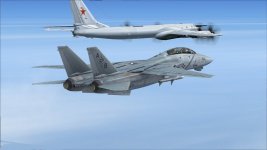I'd fall back to the opinion of the lead engineer for the design purpose:
"We were totally preoccupied with producing a fighter, with a basic weapon fit of four AIM-7's and two AIM-9's. Then we sat back and figured out how to screw six AIM-54's onto it without messing up the fighter role."
-
Robert Kress
To corroborate that statement, there are a couple of features that really made the F-14 a 4th generation fighter and standard setter for aircraft to come. In no particular order:
- Wide set engines to allow a straight air path from the inlet to the compressor to improve engine reliability in the high alpha region. This was particularly important for the still new low bypass-afterburning turbofans and was a lesson learned from the F-111, which had really nasty problems during hard maneuvering (at least the early versions).
- The above enabled very high alpha maneuvering that was previously unheard of. Like all modern fighter airframe's, "stall" is a relative term that only signify's boundary layer separation and the dissociation of drag dependence on lift coefficient. In colloquial terms, the F-14
increases lift (both force and coefficient) after the onset of stall to a peak at 30 degrees while usable lift doesn't really drop off until after 45 degrees or so.
- Because of both of the above, stability was a major issue. The F-14 had the capacity to achieve 50 degrees AoA, but this was a perilous region and really only reached at the peak of a loop where the aircraft was inverted. Two vertical stabilizers had been used before (MiG-25 in particular) to increase stability in a different region. But the F-14 was one of if not the first aircraft to really need them in the high alpha maneuvering region, because it was the first to go there. Of the 6,000 models built for wind tunnel testing, the "optimum" design had three stabilizers in a triangular configuration, but it was decidedly un-sexy and cast aside in favor of design model 303E (which became the Tomcat we all know).
Design intent aside, this has been a great discussion on the F-14! For those interested in more, two relatively inexpensive books to consider are:
How to fight and fly in the F-14: More focused on the D model, but still a good read
The great book of modern warplanes: I picked this up at an estate sale and later bought the two sister books (Modern Warplanes II and World War II airplanes.) It's one of the most informative books around is hard to find anything more era informative that doesn't have a government stamp somewhere on it.


